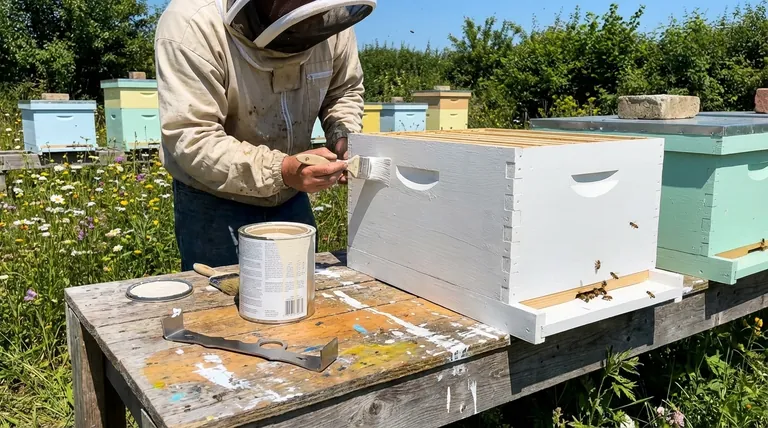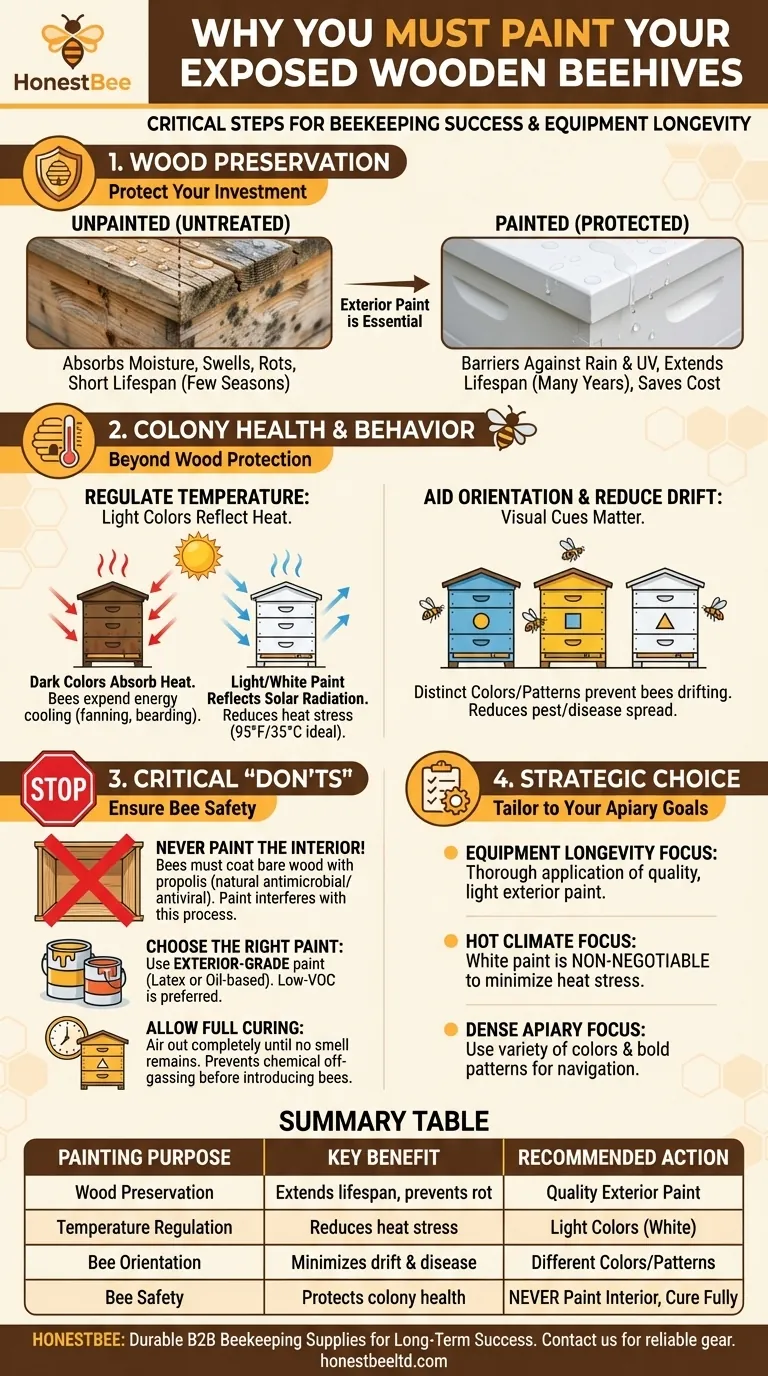In short, you must paint the exposed wooden components of your beehive. This is not a cosmetic choice but a critical step for beekeeping success. Painting serves three primary functions: it protects the wood from weather to ensure longevity, helps regulate the hive's internal temperature, and can aid bee orientation to reduce inter-colony drift.
The decision to paint a hive is a functional one, directly impacting your equipment's lifespan and your colony's health. The core principle is to protect the exterior from the elements while leaving the interior untouched for the bees to manage themselves.

The Primary Goal: Wood Preservation
The most fundamental reason to paint a hive is to protect your investment. Untreated wood, especially soft woods like pine commonly used for hives, is highly susceptible to environmental damage.
Shielding Against Moisture and Rot
Unpainted wood acts like a sponge, absorbing rain and humidity. This moisture absorption leads to swelling, warping, and eventually, fungal growth and rot, compromising the structural integrity of the hive.
Extending the Lifespan of Your Equipment
A proper coat of exterior paint creates an essential barrier against moisture and UV degradation. A well-painted hive body can last for many years, whereas an unpainted one might only survive a few seasons before needing replacement. This saves you significant cost and labor over time.
Impact on Colony Health and Behavior
Beyond simple wood protection, the choice of paint directly influences the well-being and efficiency of the honey bee colony living inside.
Regulating Internal Temperature
Bees must work to maintain a stable internal hive temperature, typically around 95°F (35°C) in the brood area. A light-colored or white paint reflects solar radiation, significantly reducing heat buildup during hot summer days.
A darker-colored hive absorbs more heat, forcing the bees to expend precious energy and water resources on cooling behaviors (like fanning and bearding) instead of foraging and brood-rearing.
Aiding Bee Orientation and Reducing Drift
In an apiary with multiple identical hives, bees can become disoriented and "drift" into neighboring colonies. This can spread pests and diseases, like Varroa mites, and weaken colonies that lose foragers to their neighbors.
Painting hives with different colors or distinct patterns provides strong visual cues for returning foragers, helping them locate their correct home with greater accuracy.
Understanding the Critical "Don'ts"
Proper hive painting is as much about what you don't do as what you do. Following these rules is essential for bee safety.
Why You Must Not Paint the Interior
The inside surfaces of the hive must be left as bare, unpainted wood. The bees will coat the interior walls with propolis, a resinous substance they collect from plants.
This propolis envelope has antimicrobial and antiviral properties, creating a sterile and healthy interior environment. Paint interferes with this natural process and can introduce chemicals that are harmful to the bees.
Choosing the Right Paint
Always use a high-quality exterior-grade paint, either latex (water-based) or oil-based. Many beekeepers prefer a low-VOC (Volatile Organic Compound) exterior latex paint, as it is easier to clean up and has fewer harsh fumes while curing.
The Importance of Curing Time
Allow freshly painted hive parts to air out and cure completely—until they no longer smell of paint—before introducing bees. This prevents the bees from being exposed to chemical off-gassing.
Making the Right Choice for Your Apiary
Your specific goals will determine your exact painting strategy.
- If your primary focus is equipment longevity: A thorough application of a quality, light-colored exterior paint is the most important investment you can make.
- If your primary focus is colony health in a hot climate: Using white paint is non-negotiable to minimize heat stress on your bees.
- If your primary focus is managing a dense apiary: Use a variety of colors and simple, bold patterns (like large circles or squares) to help your bees navigate and reduce drift.
Ultimately, proper hive maintenance is a cornerstone of responsible and successful beekeeping.
Summary Table:
| Painting Purpose | Key Benefit | Recommended Action |
|---|---|---|
| Wood Preservation | Extends hive lifespan by preventing rot and warping. | Use quality exterior-grade paint. |
| Temperature Regulation | Reduces heat stress; light colors reflect sunlight. | Paint exterior with light colors, especially white. |
| Bee Orientation | Minimizes inter-colony drift and disease spread. | Use different colors/patterns for each hive. |
| Bee Safety | Protects colony health; avoids harmful chemicals. | Never paint the interior; allow paint to fully cure. |
Protect your apiary investment and ensure your colonies thrive with the right equipment. At HONESTBEE, we supply durable, high-quality beekeeping supplies and equipment to commercial apiaries and distributors. Our wholesale-focused operations ensure you get the reliable gear you need for long-term success. Contact our team today to discuss your hive maintenance needs and explore our product catalog tailored for professional beekeepers.
Visual Guide

Related Products
- HONESTBEE Advanced Ergonomic Stainless Steel Hive Tool for Beekeeping
- Professional Dual-End Stainless Steel Hive Tool for Beekeeping
- Professional Insulated Winter Hive Wrap for Beekeeping
- Inner Beehive Cover for Beekeeping Bee Hive Inner Cover
- Professional Engraved Round Hive Number Tags for Beekeeping
People Also Ask
- Why do hive tools have a hole? Unlock the Secret to Efficient Beekeeping
- What are some common uses of a hive tool? Essential Multi-Purpose Tool for Every Beekeeper
- How should beekeepers handle bees when using a hive tool? Master Calm, Deliberate Techniques
- What tools are used for cleaning frames? A Beekeeper's Simple 4-Tool Guide
- How is a hive tool used for scraping and cleaning? Master Hive Maintenance for a Healthy Colony



















